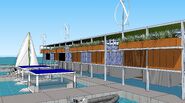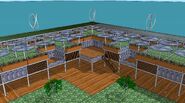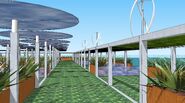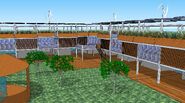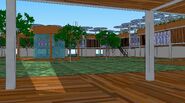Introduction[]
The Utilihab building system would be a product of the Open Source Everything Project and is essentially an Open Source variation on the aluminum T-slot framing based building systems like TomaTech and the Jeriko House system. Using larger scale profiles of the type commonly employed in industrial automation as the basis of simple modular post & beam framing, the Utilihouse system provides a plug-in-architecture platform that allows its inhabitants to freely modify structures on demand using only a few hand tools. The system is also a direct analogy to building systems employed in space applications, but still offers a high degree of elegance and comfort with a Modernist style of design.
Utilihouse and its current commercial forms employ their aluminum framing like the 'backplane' of an industrial computer, with most utilities integrated into hollow channels within the framing members themselves (normally used in industrial applications as pneumatic/hydraulic supply lines) or retrofit to it using the T-shaped slots in the frame members as attachment points. A typical square four-post room module is 4-5 meters but through the use of additional joining plates linking pairs of beam profiles together as a truss it is possible to make much larger spaces at a cost in ceiling thickness. A basic raised floor deck system works for both interior and exterior as well as for traversable roof decks. Flat roofing is the easiest form with this system and would be preferred for Seed settlement use to allow roof space to be used as decking but conventional pitched and hip roofs are also possible as are tension roofs and many forms of roof cladding can be used from alloy skin panel to thatch. Structures are finished using a vast assortment of modular panels covering walls, floors, and ceilings and made with different materials for indoor or outdoor use and which lock into the T-slot channels in various ways, usually surface-mount or in-line/flush. Planking is also usable. Most windows would be based on full floor-to-ceiling height panels and sliding doors with large glazed enclosures possibly employing the framing as a mullion system supporting planar glass panels. Interior panels may often integrate various electrical and electronic appliances -lighting especially- and in the future we may see whole-wall video monitors fabricated as wall panels. Conventional rack mounting frames also integrate into this framing, allowing for built-in mounting of many forms of electronics.
Designed for quick assembly and disassembly, this system allows whole buildings up to 5 storeys tall to be adapted as freely as an office partition system and with no particular skill on the part of users. And owing to its versatility as a building system in industrial applications, T-slot components offer unlimited possibilities for other uses -everything from furniture to robotics. Thus it is well suited to a Post-Industrial approach to living and a Modernist style of habitat design and yet is also free to use warm comforting materials such as wood, cork, and cloth reed, and possibly clay/straw composites, owing to the lack of a need for wall panels to bear any loads. Reminiscent of the materials and precision craft common to yachts and ships, it also well suits the role of dwellings in a marine environment.
The Utilihouse Seed settlement would likely employ an approach to its overall architecture very similar to classic Japanese architecture, featuring modest single or two story homes in radial compound surrounding a central community garden space. More industrial structures would radiate around the outside of this compound ring. The basic Utilihouse floor deck system would be used to create a raised outdoor deck system -most likely based on recycled plastic-wood deck planking- covering most of the settlement area, interspersed with modular gardening containers and ponds that exploit the deck framing as plumbing to support hydroponics, irrigation, and humidity control sprays. Much effort would go to design outdoor fixtures that integrate with the framing system and its aesthetics just as interior furnishings do, which would aid in providing a more physically unified community structure able to withstand bad weather or high winds. Owing to the initial high cost of the floating platform modules, there would be an immediate need to maximize space efficiency and so flat roof structures would be the norm so that their top surface can be combined and used for solar, wind, and communications systems, greenhouse gardening, and additional recreational space.
Utilihouse construction would favor milder climates and gentler sea conditions and would also be well suited to resort/tourism applications because of its blend of Asian/Polynesian, nautical, and Modernist aesthetics. The complex could readily employ either at-shore connections or could be fully free-floating and has the distinct advantage of being completely demountable and transportable worldwide no matter where a community needs to move. In fact, it's a practical possibility that a Utilihouse community founded on land could move to a marine site using its same hardware, thus offering an additional phase of incremental development transition.
Drawings and Notes[]
The above renders show a possible Utilihab seed settlement design paralleling the layout suggested in the main Aquarius article. This design features extensive use of wind and solar power with a 'solar pergola structure' supporting vacuum tube water heater arrays (black) and a similar algaeculture tubing array (green) along with a series of photovoltaic solar canopies. These are placed over a green roof equipped with hydroponic/sub-irrigation planters. Waterproof storage pod containers made of alloy or rotomolded HDPE serve for tanking, dry storage, and messier workshop space. A large 'natural' swimming pool using a companion LIving Machine artificial marsh provides a main recreation facility. Flanking it is a marina hosting a pair of first generation Solar Ferries. Along the other two sides are mariculture pens which can also be employed for additional Living Machine marsh ponds. Four large lanterns adorn the corners of the settlement. In the atrium center of the settlement a large pavilion shelters a large community aquarium hosting an artificial reef symbolizing the character of the community. Though the renders here show a dense symmetrical structure, in practice the free adaptability of the Utilihab building system would allow residents to customize their habitat on-demand.
Peer Topics[]
- Resort Prefab Complex
- Container Mod Complex
- Commercial Frame Complex
- Commercial Concrete Complex
- Organic/Ferro-cement Complex

